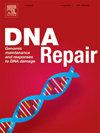DNA polymerase beta expression in head & neck cancer modulates the poly(ADP-ribose)-mediated replication checkpoint
IF 2.7
3区 生物学
Q2 GENETICS & HEREDITY
引用次数: 0
Abstract
Head and Neck Squamous Cell Carcinoma (HNSCC) imposes a significant health burden, necessitating innovative therapeutic strategies to enhance treatment efficacy. Current treatments, such as surgery, radiation, and chemotherapy, have limited effectiveness and yield severe side effects, emphasizing the need for targeted therapies. We have focused on DNA polymerase beta (Polβ) and its roles in replication stress, cellular responses to DNA damaging-therapies, and DNA damage response modifiers. Our investigations reveal a regulatory role for base excision repair (BER) proteins, including Polβ, in the cellular response to inhibitors of poly(ADP-ribose) glycohydrolase (PARG), an enzyme involved in poly(ADP-ribose) (PAR) degradation. The inhibition of PARG, in HNSCC cells, elicits replication stress and activates the PAR-induced S-phase/ATR checkpoint, leading to a block to replication, cell cycle arrest, and the onset of apoptosis. However, Polβ overexpression mitigates this response, reducing replication-stress-induced PAR foci formation, suggesting a modulation of replication checkpoint activation. We found that PARG inhibitor treatment is ineffective on HNSCC cells that overexpress Polβ, implying that the PARG inhibitor-induced PAR and apoptotic response is dependent on the level of Polβ. Further, our in vitro experiments demonstrate that combining PARG and ATR/CHK1 inhibitors overcomes Polβ-mediated treatment resistance in HNSCC cells, producing synergistic effects compared to the individual treatment conditions. Our findings suggest a possible treatment paradigm for HNSCC, employing ATR or CHK1 inhibitors in combination with PARG inhibitors. This strategy offers a promising path for more effective HNSCC treatments, potentially overcoming Polβ-related resistance.
DNA聚合酶β在头颈癌中的表达调节poly(adp -核糖)介导的复制检查点
头颈部鳞状细胞癌(HNSCC)造成了巨大的健康负担,需要创新的治疗策略来提高治疗效果。目前的治疗方法,如手术、放疗和化疗,效果有限,并产生严重的副作用,强调需要靶向治疗。我们专注于DNA聚合酶β (Polβ)及其在复制应激、细胞对DNA损伤治疗的反应和DNA损伤反应修饰剂中的作用。我们的研究揭示了碱基切除修复(BER)蛋白,包括Polβ,在细胞对聚(adp -核糖)糖水解酶(PARG)抑制剂的反应中起调节作用,PARG是一种参与聚(adp -核糖)(PAR)降解的酶。在HNSCC细胞中,PARG的抑制引发复制应激并激活par诱导的s期/ATR检查点,导致复制受阻、细胞周期阻滞和细胞凋亡的发生。然而,Polβ过表达减轻了这种反应,减少了复制应激诱导的PAR焦点形成,表明复制检查点激活的调节。我们发现,PARG抑制剂对过表达Polβ的HNSCC细胞无效,这意味着PARG抑制剂诱导的PAR和凋亡反应依赖于Polβ的水平。此外,我们的体外实验表明,联合使用PARG和ATR/CHK1抑制剂可以克服pol β介导的HNSCC细胞耐药,与单独的治疗条件相比,可以产生协同效应。我们的研究结果提示了一种可能的HNSCC治疗模式,即使用ATR或CHK1抑制剂与PARG抑制剂联合使用。这一策略为更有效的HNSCC治疗提供了一条有希望的途径,有可能克服pol β相关的耐药性。
本文章由计算机程序翻译,如有差异,请以英文原文为准。
求助全文
约1分钟内获得全文
求助全文
来源期刊

DNA Repair
生物-毒理学
CiteScore
7.60
自引率
5.30%
发文量
91
审稿时长
59 days
期刊介绍:
DNA Repair provides a forum for the comprehensive coverage of DNA repair and cellular responses to DNA damage. The journal publishes original observations on genetic, cellular, biochemical, structural and molecular aspects of DNA repair, mutagenesis, cell cycle regulation, apoptosis and other biological responses in cells exposed to genomic insult, as well as their relationship to human disease.
DNA Repair publishes full-length research articles, brief reports on research, and reviews. The journal welcomes articles describing databases, methods and new technologies supporting research on DNA repair and responses to DNA damage. Letters to the Editor, hot topics and classics in DNA repair, historical reflections, book reviews and meeting reports also will be considered for publication.
 求助内容:
求助内容: 应助结果提醒方式:
应助结果提醒方式:


